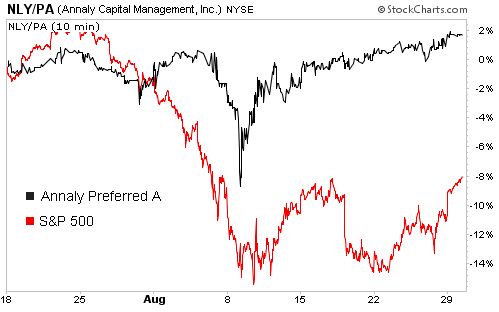The Safest 7% Yield in America
There is one thing is on every investor’s mind right now: safety.
As of last week, fears of a global economic slowdown erased close to $3 trillion in market value from U.S. stocks since July 22.
#-ad_banner-#And the Volatility Index (VIX) — considered a measure of “fear” in the market — reached a recent high of 48 on Aug. 8, after the S&P 500 dropped 17% in two weeks.
So the question investors have now is how can you protect your money while also earning a decent return? Should you cash out and stick it in the bank? Purchase Treasury bonds?
Most savings accounts pay less than 1%. And 10-Year Treasury bonds only yield 2.3%.
But I’ve found a low-risk security that’s paying more than 7%, making it an attractive alternative to low-yielding Treasuries and bank accounts.
You could even call it a “double-safe” investment because it provides two layers of safety. This doesn’t mean it can’t lose money, but at this point, it might just be the safest 7% yield in America.
You can see how well this security — Annaly Preferred 7.875% Series A (NYSE: NLY-PA) — has held up against the broader market during the sell-off:
At its worst, Annaly’s “Preferred A” stock lost about 8% (roughly half the S&P’s 17% fall). But at this level, the shares bounced back quickly… while the S&P languished.

So what makes this security hold up in a rough market?
These preferred shares are issued by Annaly (NYSE: NLY), a mortgage real-estate investment trust or “M-REIT.” This company borrows at record-low rates and then invests in a basket of mortgage-backed securities.
But isn’t this risky? After all, investors were left with a bad taste in their mouths when mortgage-backed securities tanked in the financial crisis of 2008-09.
Well, NLY-PA’s first layer of safety comes from the fact that its parent company invests in mortgages backed by government-sponsored agencies Fannie Mae and Freddie Mac.
You probably remember during the financial crisis three years ago, the U.S. government bailed out Fannie and Freddie. These two agencies still have their problems, but the mortgage securities they issue are considered as credit-worthy as U.S. Treasuries. This is because agency securities are backed by an implicit guarantee from the U.S. government.
Because Annaly’s holdings continue to be backed by the U.S. government, its portfolio is all but shielded from credit risk.
But this is not the only factor that plays into the safety of these shares. Its second layer of safety lies in the fact that you’re investing in preferred shares, not common stock.
Preferred shareholders have priority over common stock shareholders. In short, they get paid first. And the preferreds also have a $25 par value — the price at which the company can call them back. Because of this and their set dividend rate (NLY-PA pays $0.492 a share each quarter, for a yield of more than 7%), these securities trade more like bonds than stock.
Meanwhile, Annaly is making more than enough to cover the payment on the preferred stock. The trust reported in its last quarterly statement that it earned $957 million in interest from its portfolio, easily covering the $4.3 million it paid in preferred dividends.
Now, just because I think these securities are safe right now doesn’t mean they will be safe forever. For instance, rising interest rates would increase borrowing costs for Annaly, which would hurt earnings.
Action to Take –> With the Federeal Reserve announcing plans to keep rates low until 2013 and the enormous cushion between earnings and preferred dividends, I think the safety of these shares will continue well into the foreseeable future. One important note — the shares do trade at a slight premium to their $25 par value. If called, investors would see a slight capital loss from today’s levels.
[Note: Since I first recommended Annaly’s preferreds to subscribers of my newsletter High-Yield Investing in February 2009, the shares have kept our money safe, paid a reliable dividend through thick and thin, and kicked back a total return of +51.1%. If you’d like to find out more about the investments I’m finding for High-Yield Investing visit this link.]
